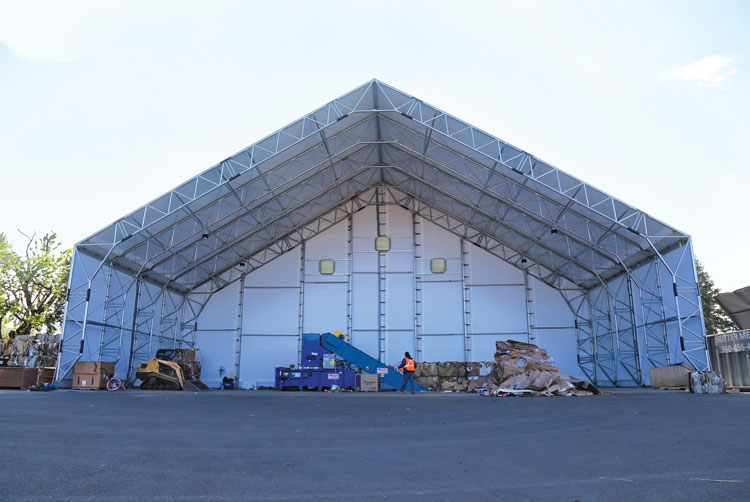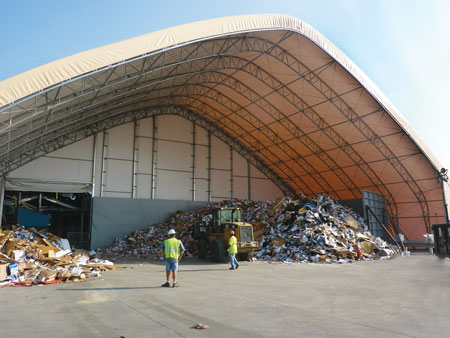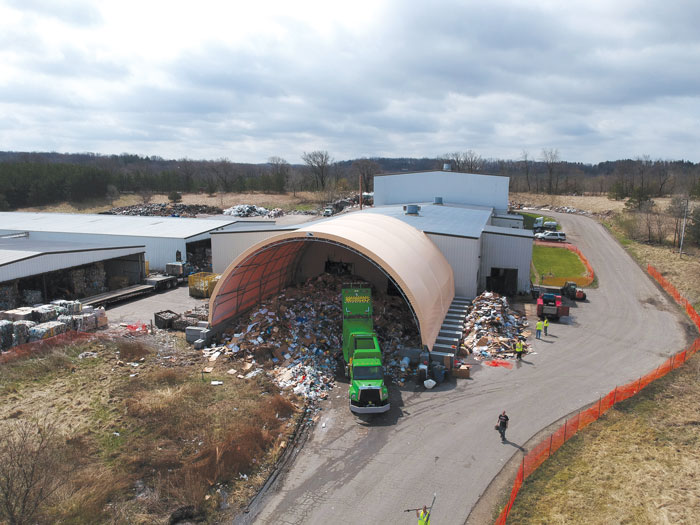A fabric structure with a clear span design, corrosion-resistant frame, natural light and ventilation, and customization options can help to maximize operation efficiency at every level of the waste management facility.
By Janine Coppola and Geoffrey Ching
Businesses are always looking to become more efficient, and the waste management industry is no exception. With many moving parts and variables in a waste management facility, facility managers do everything they can to make their operation run as smoothly as possible—from adding state-of-the-art equipment to redesigning their facilities.
For waste management facilities looking to maximize efficiency, look no further than a fabric building. Fabric structures are a worthwhile investment for many reasons, but primarily for their unique engineering and design, which enhance the efficiency of any operation.

Photos courtesy of ClearSpan.
When looking for a fabric structure, there are a few key features facility managers should seek out. Fabric structures with a clear span design ensure an efficient workflow and maximized storage, while those with a strong steel frame and translucent fabric cladding provide a tough, yet breathable structure. Brands that offer many customization options are able to perfectly tailor the structure to a business’s needs to create their ideal—and most efficient—waste management facility.

Workspace Design
When looking for a fabric building, facility managers should opt for a structure that has a clear span design. This means that a structure has a lack of internal support posts, thus allowing for maximum usable space. This unobstructed space ensures ease of movement around the structure, as well as ample room for equipment, materials, storage and building accessories.
A clear span design also provides increased maneuverability for equipment and vehicles, as well as employees. A clean, open workspace ensures an efficient workflow throughout the day without any hindrance or obstruction of anyone’s path. Increased storage also helps to keep equipment and materials out of the way. Different companies offer different options to add storage space to fabric buildings, with some even able to build their structures directly onto shipping containers.
Businesses should design their space for maximum operational efficiency by customizing the layout of the building to meet their precise business needs. By designing the interior of their structure with daily processes in mind, waste management facilities can make their operation more efficient. Engineers and designers approach each opportunity by listening to the goals and concerns of the facility managers to make the most of every cubic foot of the facility. Customers who have built facilities for waste management appreciate the versatility of these clear span designs.
The clear span design of fabric structures allows companies to tailor floor plans to even the most specific requirements. With designs like this, waste management facilities can now have a building designed to meet the exact needs of their day-to-day procedures in order to maximize their operational efficiency.
Structural Integrity
Fabric structures are ideal for harsh environments and can generally withstand just about anything thrown their way. A strong, durable building provides the perfect foundation for an efficient facility. Facility managers should look for a fabric structure that has a corrosion-resistant frame, since waste management facilities often create a corrosive environment. Two options to be on the lookout for are epoxy paint-coating and galvanized steel.
Waste management facilities often handle a wide variety of materials, meaning corrosion-resistant coatings extend the range of substances able to be processed without concern or compromising the frame integrity.
Many materials housed in these facilities can create unpleasant odors, but the increased airflow a fabric building can provide helps to manage this. Ventilation is key in a waste management facility, so facility managers should opt for a structure designed to be conducive to natural ventilation. Companies can usually add additional ventilation to fabric structures as well, if needed.
Natural light and ventilation should be maximized in each fabric structure design. When facilities need to be enclosed, mechanical air-exchange systems can be designed to bring in completely new, fresh air as often as every three to five minutes.
In addition to natural ventilation, facility managers should choose fabric structures that provide an abundance of natural light. Look for a fabric cover that allows sunlight to filter into the structure, which can eliminate the need for artificial lighting during the day. Also look for a fabric cover that is climate sensitive, meaning it keeps the interior cooler in the summer and warmer in the winter. Both of these factors reduce utility costs, saving businesses money in the long run. With the waste management industry always trying to become more energy efficient, a fabric structure is a great place to start.
As we have learned from the past year, covered environments that include sunlight and natural breezes are better for the health and safety of people and often benefit the materials under cover. By leaving end and sidewalls open when appropriate, there are project cost savings in addition to an improved environment.
It is important for facility managers to look for structures that come with a lengthy warranty, so they can count on their fabric structure to last as long as they need. These warranties provide peace of mind, ensuring a long lifespan with decades of use. Waste management facilities are designed for tough conditions both inside and out. Customers are continuously impressed by the incredible strength of engineered steel frames and the resiliency and longevity of fabric covers.

Customizable
Facility managers should choose a fabric structure that is customizable down to the last detail, so they can get the exact building to fit their needs and optimize their operational efficiency. Fabric buildings can be built to a variety of sizes, so any business can benefit from the many advantages of a fabric structure. It is also important to choose a brand that offers a variety of foundation options. For example, some companies offer shipping containers as a fabric structure foundation. Shipping containers are ideal for an operation that needs added storage space and a sturdy, dependable foundation all in one.
A helical anchor solution is unique in that it is technically temporary, yet strong enough to serve as a permanent foundation. These anchors drill directly into the ground, requiring little to no site work, and can easily be removed so the building can be relocated at any time. Many fabric structures can be expanded upon and moved, so they are able to grow and change along with a business and its needs. Whether a structure needs to grow, move or be taken down, fabric structures allow for necessary changes to be made with relative ease. Facility managers should look for a company that offers fast construction timelines and quick installation. This will ensure that they can start using their fabric structure as soon as possible and limit lost revenue due to construction time.
Many fabric structure brands offer different accessories as well, so facility managers should opt for a company that offers a wide range of accessories, such as doors, windows, ventilation and more. Businesses can tailor their building to their exact needs and add in any accessories that will make their operation run as smoothly and efficiently as possible.
Value-Engineered Solutions
Most often, waste management customers are looking for value-engineered solutions. We ask a series of questions when new inquiries are received to make certain the structures are not under- or over-designed, based on each specific need. Often specific sidewall height clearances are required to accommodate large equipment, while others simply request the lowest possible square footage for covered storage.
With efficiency as a top priority, waste management facilities can achieve this goal by looking for a fabric structure with several key features in mind. A fabric structure with a clear span design, corrosion-resistant frame, natural light and ventilation, and customization options can help to maximize operation efficiency at every level of the waste management facility. | WA
Geoffrey Ching is Director of Sales at ClearSpan Structures.
Janine Coppola works for ClearSpan Structure.
For more than 40 years, ClearSpan has been providing the waste and recycling industries with innovative building solutions. For more information visit www.clearspan.com
